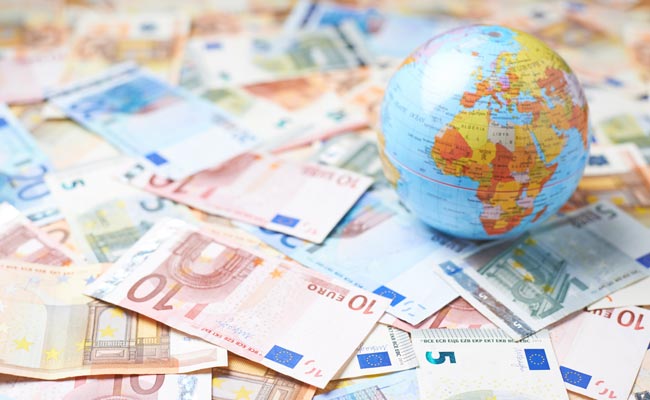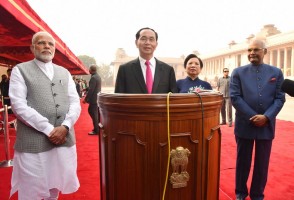
Government trying to put foreign investments on fast track
Naveen Kumar | The Dollar Business  The FIPB (The Foreign Investment Promotion Board), under the chairmanship of Finance Secretary, Rajiv Mehrishi, will consider 32 FDI proposals in its next meeting on April 9, 2015. The companies whose proposal would be discussed for clearance by the Board include Decathlon S.A, France, Warden Petrochem Pvt. Ltd, Richemont Services B.V, Holland, Nickelodean Asia Holdings Ltd., Singapore, Blue Dart Express Limited among others. These cases include deferred decisions, appeal against earlier rejection or request for some amendment of earlier approval. In the last meeting that was held on March 28, 2015, FIPB cleared 10 Foreign Direct Investment (FDI) proposals worth Rs 2858 crores, while it differed 18 proposals due to various reasons. Currently FDI proposals worth Rs 1200 crores or below is approved by FIPB, while any proposal above Rs 1200 crores has to go to CCEA (Cabinet Committee on Economic Affairs). Government in its effort to show its seriousness and intent in welcoming FDI has already allowed higher investment into insurance sector and has opened railways for foreign investment. However Foreign Institutional Investment (FII), which is relatively shorter term investment by foreign players is a major source foreign exchange volatility in India. The top leadership of ASSOCHAM will do a brainstorming with senior Government officials, on ways to get the right balance between the Foreign Direct Investment (FDI) and portfolio inflows in the capital market so that India`s vulnerabilities concerning global capital flows are reduced, given the volatility in the financial markets. As thrust to the manufacturing would be a key to attracting FDI in the Indian industry, the `Make in India` is going to be a game-changer. It is in this context that top leadership of the ASSOCHAM including Rana Kapoor, President, Sunil Kanoria, Sr. Vice President, said “With the government pursuing with the reforms measures, we expect this balance to really move towards attractive FDI, while we keep the confidence of portfolio investors intact”. "If we are able to convince the global investors to come and make India their world factory, our problem of capital flows would be solved on a sustained basis. First they would bring in FDI for setting up facilities and then earn export remittances by worldwide supplies from the Indian manufacturing hubs", ASSOCHAM Secretary General D S Rawat said. The foreign investment, or the total capital flows, into India have been rather robust in the current fiscal year. The net inflows were about US$ 25 billion on account of the Foreign Direct Investment (FDI) and US$ 36 billion as portfolio flows in the capital market (USD 61 billion in all). This compares very well against US$ 21 billion of FDI and (-) US$ 1 billion portfolio in the corresponding period of the last year. For the fiscal that will be ending on March 31, India would have more than enough capital flows to fund its Current Account. That said, are we really comfortable and can we afford to sit back and relax just because at this point of time we have good amount of foreign exchange reserves and the rupee has managed to stay steady even when other emerging markets currencies have come under pressure against dollar? To get things in perspective, such an optimistic scenario has been unfolding for India despite the fact the going has not been good in several parts of the world. The picture may not be perfect for India, but see how the global economic landscape looks like. According to IMF, global growth in 2015-16 would be between 3.5 and 3.7 per cent. The latest estimates are 0.3 per cent lower than the projections in October 2014. The situation is not quite optimistic in China, Russia, the Eurozone and Japan. As per the World Bank the growth projection for 2015 has been revised downward from 3.4 per cent to 3.0 per cent. Among the Emerging Market Economies (EME), weaknesses have been observed in China, Russia, Brazil and Indonesia. While the overall EME growth has been projected at 4.3 per cent for 2015 and 4.7 per cent in 2016, the Indian economy would still grow by 6.3 per cent says the World Bank. In fact, we would emerge, in all probability, as the fastest growing in the world, if we go by the estimates of the Government of India (GoI) in excess of seven per cent. Such an optimistic scenario explains the reasons for the robust capital flows into India, also influenced by a string of policy decisions and legislative road blocks cleared. For instance, the hike in FDI limit in the insurance sector itself would get us US$ 4 billion of additional flows.
The FIPB (The Foreign Investment Promotion Board), under the chairmanship of Finance Secretary, Rajiv Mehrishi, will consider 32 FDI proposals in its next meeting on April 9, 2015. The companies whose proposal would be discussed for clearance by the Board include Decathlon S.A, France, Warden Petrochem Pvt. Ltd, Richemont Services B.V, Holland, Nickelodean Asia Holdings Ltd., Singapore, Blue Dart Express Limited among others. These cases include deferred decisions, appeal against earlier rejection or request for some amendment of earlier approval. In the last meeting that was held on March 28, 2015, FIPB cleared 10 Foreign Direct Investment (FDI) proposals worth Rs 2858 crores, while it differed 18 proposals due to various reasons. Currently FDI proposals worth Rs 1200 crores or below is approved by FIPB, while any proposal above Rs 1200 crores has to go to CCEA (Cabinet Committee on Economic Affairs). Government in its effort to show its seriousness and intent in welcoming FDI has already allowed higher investment into insurance sector and has opened railways for foreign investment. However Foreign Institutional Investment (FII), which is relatively shorter term investment by foreign players is a major source foreign exchange volatility in India. The top leadership of ASSOCHAM will do a brainstorming with senior Government officials, on ways to get the right balance between the Foreign Direct Investment (FDI) and portfolio inflows in the capital market so that India`s vulnerabilities concerning global capital flows are reduced, given the volatility in the financial markets. As thrust to the manufacturing would be a key to attracting FDI in the Indian industry, the `Make in India` is going to be a game-changer. It is in this context that top leadership of the ASSOCHAM including Rana Kapoor, President, Sunil Kanoria, Sr. Vice President, said “With the government pursuing with the reforms measures, we expect this balance to really move towards attractive FDI, while we keep the confidence of portfolio investors intact”. "If we are able to convince the global investors to come and make India their world factory, our problem of capital flows would be solved on a sustained basis. First they would bring in FDI for setting up facilities and then earn export remittances by worldwide supplies from the Indian manufacturing hubs", ASSOCHAM Secretary General D S Rawat said. The foreign investment, or the total capital flows, into India have been rather robust in the current fiscal year. The net inflows were about US$ 25 billion on account of the Foreign Direct Investment (FDI) and US$ 36 billion as portfolio flows in the capital market (USD 61 billion in all). This compares very well against US$ 21 billion of FDI and (-) US$ 1 billion portfolio in the corresponding period of the last year. For the fiscal that will be ending on March 31, India would have more than enough capital flows to fund its Current Account. That said, are we really comfortable and can we afford to sit back and relax just because at this point of time we have good amount of foreign exchange reserves and the rupee has managed to stay steady even when other emerging markets currencies have come under pressure against dollar? To get things in perspective, such an optimistic scenario has been unfolding for India despite the fact the going has not been good in several parts of the world. The picture may not be perfect for India, but see how the global economic landscape looks like. According to IMF, global growth in 2015-16 would be between 3.5 and 3.7 per cent. The latest estimates are 0.3 per cent lower than the projections in October 2014. The situation is not quite optimistic in China, Russia, the Eurozone and Japan. As per the World Bank the growth projection for 2015 has been revised downward from 3.4 per cent to 3.0 per cent. Among the Emerging Market Economies (EME), weaknesses have been observed in China, Russia, Brazil and Indonesia. While the overall EME growth has been projected at 4.3 per cent for 2015 and 4.7 per cent in 2016, the Indian economy would still grow by 6.3 per cent says the World Bank. In fact, we would emerge, in all probability, as the fastest growing in the world, if we go by the estimates of the Government of India (GoI) in excess of seven per cent. Such an optimistic scenario explains the reasons for the robust capital flows into India, also influenced by a string of policy decisions and legislative road blocks cleared. For instance, the hike in FDI limit in the insurance sector itself would get us US$ 4 billion of additional flows.
This article was published on March 30, 2015.






 to success.
to success.